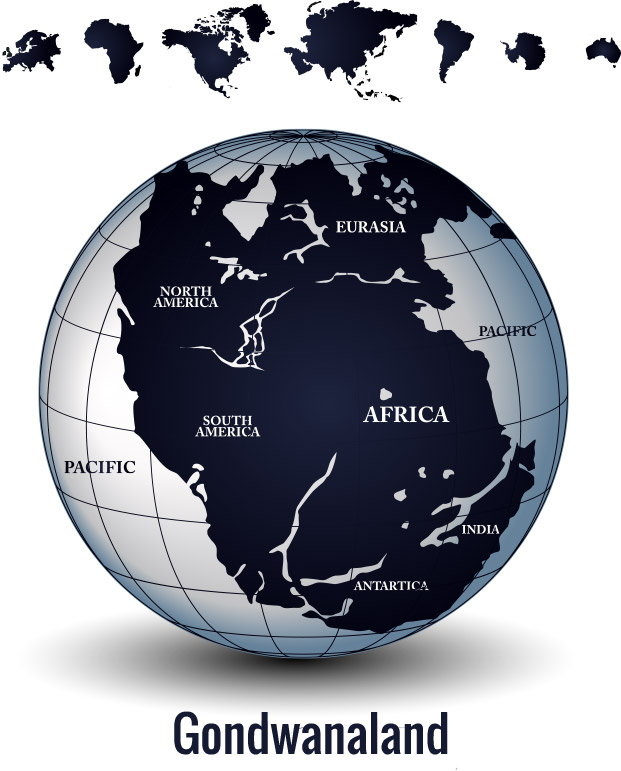
More than 100 million years ago before the Tertiary Period, Australia was connected to the Antarctic land mass that formed the super-continent known as 'Gondwanaland'.
This southern land mass was mostly above sea level until the beginning of the Tertiary Period, 65 million years ago, when a series of extreme climate cycles weathered and eroded parts of Gondwanaland.
Australia separated from Gondwanaland approximately 55 million years ago along the southern boundary of what is now the Australian continent. This splitting of Australia from Gondwana caused the sea to flood land areas which had been free of the ocean for hundreds of millions of years.

This led to a series of basins being formed and Adelaide was built on the coast of one of the basins, Gulf St Vincent. This area offered a wide belt of coastal dunes and wide sandy beaches stretching continuously north to south for 30 kilometres in the areas stretching from Seacliff to Outer Harbour, broken only at the Patawalonga Creek.
An excellent example of Adelaide's coastal dunes can be found at Tennyson. These dunes were formed 10,000 years ago when the sea level rose to its current height, creating an extensive dune barrier system 200-300 metres wide and 10-15 high.
What are Sand Dunes?
A dune is a mound of sand formed by the wind, usually along the beach or in a desert. Dunes form when the wind blows sand into a sheltered area behind an obstacle. Dunes grow as the grains of sand accumulate. Dunes can also be formed by strong currents beneath the water moving sand particles onto the beach.
Coastal sand dunes are small ridges or hills of sand found at the top of a beach, above the usual maximum reach of the waves. They are formed by strong onshore winds (greater than 5 m/sec) blowing sand that is deposited against an obstruction such as a bushes, driftwood or rocks or at the base of cliffs and hills.
Plants seeds are blown or transported by fauna onto coastal dunes and grow in a series of stages from the pioneer plants which initially cover the bare sand e.g. spinifex, to the secondary stabilising plants which form the more permanent plant cover.
Dune fields comprise a variety of dune types including transverse and parabolic dunes. They range from relatively small shore-parallel fore-dunes that sit immediately behind the beach, tens of metres wide and a few metres thick to a series of dunes that may extend hundreds of metres to a few kilometres inland, representing long-term accumulation of large volumes of sand.

Where does sand come from?
Sand is a loose granular material blanketing the beaches, riverbeds and deserts of the world.
Earth's landmasses are made up of rocks and minerals, including quartz, feldspar and mica. The most common component of sand is silicon dioxide in the form of quartz. Weathering processes — such as wind, rain and freezing/thawing cycles - break down these rocks and minerals into smaller grains.
Beaches are a common feature of a coastline and are made up of eroded material that has been transported from elsewhere and deposited by the sea.
Beach sand is made mostly of material weathered from inland rocks or sea cliff material and transported to the beach on the wind or in rivers; and/or from shells and the calcium, a mineral in seaweed and other hard fragments of marine organisms originating in the ocean.
Beach sand is composed of different materials that vary depending on location and therefore comes in an array of colors including white, black, green and even pink.
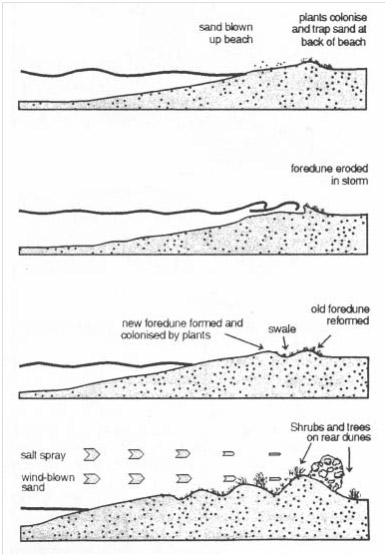
(The Adelaide Metropolitan Coastline - South Australian Coast Protection Board No. 27 April 1993)
What do Coastal Sand Dunes do?
Coastal sand dunes are nature's way of protecting the beaches from erosion. Coastal dunes provide a buffer zone between marine and land environments. They absorb and decrease wave energy and reduce storm damage to our coastline.
Dunes stop the inland flow of seawater but they erode without vegetation cover.
Dune structures support a wide variety of bird, reptile and invertebrate species.
Coastal sand dunes are extremely sensitive to disturbances. They suffer severe damage from pedestrian and vehicle traffic.
When beach sand is washed away by storms, wind or wave movement, it is normally replaced by sand stored in the dune. Human activities can severely reduce this store of dune sand.
Waves approach the beach at an angle. This sets in motion a current which moves up the coast. The sand is carried in the current. Longshore drift is defined as the movement of sand in the surf zone along the coast. It is also known as littoral sediment transportation.
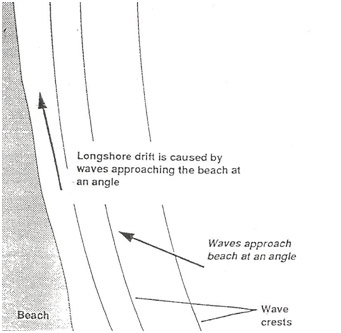
Waves approach the beach at an angle. This sets in motion a current which moves up the coast. The sand is carried in the current. Longshore drift is defined as the movement of sand in the surf zone along the coast. It is also known as littoral sediment transportation.
Natural and Human impacts on Dunes
Prior to European colonization, the Adelaide area (Kaurna Meyunna country) hosted a three-dune system (fore, mid and hind) with two swales (dips or hollows). The dunes had a natural cycle of sand replenishment and supported extensive tidal mangrove, swamp paperbark and samphire wetlands east of the hind dunes. The area supported a rich biodiversity and a resilient ecosystem.
Since 1836, the Adelaide region, including the coastal dunes, offered settlers an abundant source of building materials, grazing land, timber for fuel, and residential land.
However, since European settlement the dunes on Adelaide's coast have suffered disrespect and degradation from cattle and pig grazing, tree felling for building and fuel, sand-mining for building and glass making, WW2 25lb guns test fired into the dunes, housing developments, rubbish dumping, illegal encroachment, deliberately-lit and accidental fires and other destructive actions by humans and feral animals.
Much of the foreshore development occurred in the 1940's, and major storms in the 1940's and 50's highlighted that the metropolitan coastline was far from stable. These storms created widespread damage to properties along the foreshore, and increased public awareness about the need to protect both public and private property due to the effects of the natural coastal processes.
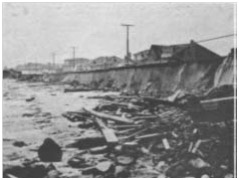
Storm Damage - Glenelg, 1964
The Tennyson Dunes (named after Lord Tennyson, Governor of SA 1899-1902) are 22 hectares of coastal dunes with natural grass and shrub land. They are the last true remnant of the Adelaide metropolitan coastal plains and a coastal conservation reserve. Located 12 kilometres north-west of the city, Tennyson Dunes display a large diversity of native flora and support the presence of rare and regionally significant plants, birds, reptiles and invertebrates.
The plants in the Tennyson Dunes are an insight into what can survive and thrive in our changing climate and the best example of Adelaide's natural coastal biodiversity. For instance: Coastal Spinifex - a grass that is important in stabilising dunes; Coastal Daisy Bush - a good screening plant; Coastal Wattle - excellent shelter and attracts birds and insects; Native Pigface - succulent ground cover and its fruits were a food source for the Kaurna people; Dryland Tea-Tree - a hardy plant providing good shelter, attracting birds and insects.
Native plants are naturally adapted to harsh conditions and attract native fauna.
Tennyson Dunes are extremely significant for reptile life including the regionally threatened Painted Dragon. Although rarely visible (as they try to avoid humans) Brown Snakes can sometimes be seen. They are a vital part of dune ecology because they keep mice and rat populations under control.
Tennyson also provides breeding grounds and habitat for many bird species including birds of prey such as the Nankeen Kestrel and the Black-shouldered Kite.
The Dune Group has recently restored populations of the Coastal Bitterbush which is the only food plant for the endangered Bitterbush Butterfly.
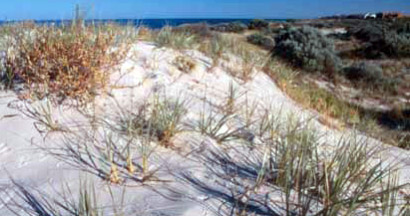
Tennyson Dunes
Adelaide's Living Beaches - A Strategy for 2005-2025. Department for Environment and Heritage
The dunes are being heavily tested by competing factors such as invasive non-native plants, pedestrian traffic, feral and domestic animals and a proposed bike track. The Tennyson Dunes Group are a dedicated volunteer conservation group working to provide a safe sanctuary for flora and fauna and to improve the dunes as a valuable community asset by enhancing the natural values of the dunes as well as protecting their heritage and educational significance.
(adapted from website: http://www.tennyson.org.au/)
Climate Change and Dunes
Over the last 4,000 years the sediment supply from offshore sources has declined to the point where far less sediment is being transported ashore to Adelaide's beaches. Ongoing sea level rise and subsiding land in Adelaide is also contributing to beach and dune erosion.
In 1993, the South Australian Government's 'Coast Protection Board' recommended that allowance be made for 0.3 metre rise in average sea level from the year 1991 to 2030, and a further 0.7 metre rise from 2030 to 2100.
(The Adelaide Metropolitan Coastline - South Australian Coast Protection Board No. 27 April 1993)
Another way in which sand dunes are eroded is by the wind remobilizing sand and blowing it out of the dune, a process known as deflation. The most common deflation feature is the blowout, a bowl-shaped depression with a flat floor that lies below the elevation of most of the adjacent dunes. Blowouts are flat-floored because the sand is blown away until the sand surface reaches the top of the water table.
As storm and wind events increase in frequency and ferocity due to climate change, the frequency of blowouts in dune systems also increases.
Combined with natural and climate change events, loss of vegetation through the tracks made by pedestrians and vehicles through dunes also increases the chances of blowouts and dune erosion.
Blowouts 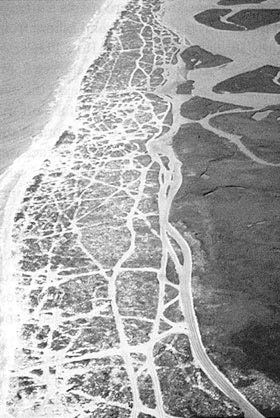
Beach buggy trails through the dunes. Unrestricted vehicular (and pedestrian) traffic is damaging to dune vegetation.
https://coastalcare.org/educate/sand-dunes/
Aboriginal Culture and Dunes
Prior to European colonisation the Adelaide Aboriginal people [Kaurna Meyunna] had established:
"...a strong connection to Wongayerlo; the sea, the foreshore and the sky. Wongayerlo is the place where the sand dunes rise straight up from the sea like a headland (forehead) and run certain directions like veins down your arm. The coastal dunal systems were essential traditional cyclic living and burial places for the Kaurna people during the time of Woltatti (Bush Turkey Totem and Constellation), the hot summer months when the north wind would come and the mosaic burn off time would begin.
Kaurna have sustainably managed the natural resources of this environment through cultural practices for untold generations. Amongst the dunes, coastal plants were foraged for food and for materials to build nets, spears and fishing line. Harvesting of vulnerable plants and animals was carried out according to seasons to ensure that animals, plants and people could live in a harmonious balance.
The coastline was a very productive seasonal area and many stories, songs and skills would be transferred and practised during these cyclic times of intentional movement. The dunal systems provided the ideal environment for Kaurna meyunna to seek shelter from wind and the heat of the sun during the day. They used the sand dunes as their protected camping grounds and here they would prepare and mend fishing nets to catch the runs of fish between the sand bars running along the coastline.
Kaurna meyunna were highly skilled in and knowledgeable about the use of fibre and made a multitude of nets, string, baskets and mats for use throughout the seasons of movement to and from the known camp sites and food places. This acute knowledge of fibre, or deeper understanding of the culture of fibre, ensured that the makers knew how to best utilise their time within the natural environmental cycles to collect food and meet material needs.
The intersection between rivers and ocean, salt/fresh water mixed estuaries, were hotspots of plant and animal diversity that the Kaurna utilised to collect food and other resources. Kaurna meyunna hunted sand goanna and their eggs, snakes, kangaroo rat and various birds and their eggs. They also picked a range of vegetable foods, medicines and gums/resins for use and trade.
The utilisation of the coastal area is evident by the numerous traditional living, cemetery and midden sites that have been found along the metropolitan coast and remnant dunal systems. For instance, the remnant sand dunes at Port Noarlunga hold significant midden sites, exemplars of Kaurna occupation and utilisation of dunal systems."
(excerpts from The City of Charles Sturt - Kaurna Meyunna Cultural Mapping - A People's Living Cultural Landscape by Karl Winda Telfer and Gavin Malone)
Negative Economic Impacts of Dune Loss
The negative impacts of the loss of coastal sand dunes include:
The huge costs of dredging sand from other areas of the coastline and inland sources or sand pumping activities to replenish and nourish Adelaide beaches where there is insufficient natural supply of sand or degradation of dunes by human activities or feral and domestic animals.
The cost of rock-wall and groyne construction where there is beach erosion is substantial due to human activities such as residential and commercial construction on foreshores and dunes.
A greater threat to coastal properties leading to increased property and business damage, repairs and insurance costs through wave action and storm energy without the natural protection of dunes systems.
Loss of income from recreational and tourism activities associated with eroded beaches and poor quality foreshores and estuaries.
The ripple effect of the loss of dune vegetation causing the destruction of coastal habitat and loss of diversity of dune flora and fauna species that can lead to the eventual loss of dunes through lack of stabilizing vegetation. Bird-watching and other passive nature-tourism activities are contemporary economic drivers heavily affected by dune loss.
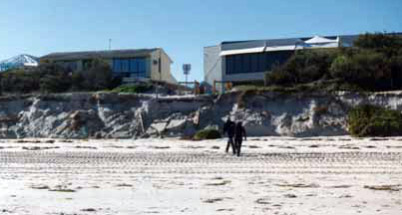
Semaphore Park 1999
Adelaide's Living Beaches - A Strategy for 2005-2025. Department for Environment and Heritage
What next for Adelaide's Dunes?
The coastline is dynamic, always shifting in response to the wind and waves. However, human impacts have altered the dynamics of the coast to such an extent that natural processes can no longer sustain the beaches.
In 1972 the Coast Protection Act was passed by State parliament. It established a Coast Protection Board to provide management expertise not only for the metropolitan beaches but for the entire 4,000 kilometres of the South Australian coastline. However, the coastal erosion and encroachment of development within the Adelaide region has meant that the metropolitan beaches continue to require considerable research and management attention.
Today, there is no naturally continuing replenishment source of sand. When this is combined with a net northerly littoral drift and an increasing mean sea level, the long term effect is the need to artificially maintain the beaches, or eventually lose them.
Adelaide's coastline is now a highly managed one. The sand that forms the beaches is a scarce and moving asset. The future management of the beaches needs to be responsive to changing conditions to ensure that future generations are not disadvantaged by decisions today.
The Government's Living Coast Strategy (2004), the beach management strategy for 2005-2025, continues to manage erosion risks to metropolitan coastal assets by replenishing beaches and using structures in critical locations to slow the northerly drift of sand. In addition, the strategy contains three important initiatives.
The first is to recycle sand more effectively using pipeline transfer systems.
The second is to add sand from external sources to the beach system to counter the ongoing loss of dune volume and beach width caused by sea level rise and other factors.
The third is to integrate sand bypassing at harbours with beach management.
These initiatives will contribute to achieving the actions listed in South Australia's Strategic Plan (2004), including maintaining the lifestyle quality of South Australians, seeking creative solutions to environmental issues and increasing investment in strategic areas of infrastructure.
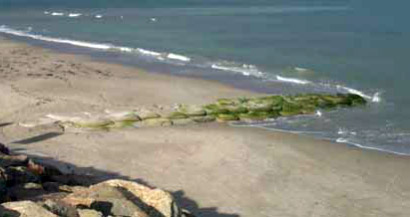
Geotextile groyne at Somerton Park, 2003
Adelaide's Living Beaches - A Strategy for 2005-2025. Department for Environment and Heritage
The main components of the strategy for managing Adelaide's beaches from 2005 to 2025 include:
Continue beach replenishment -
Continue the existing program of beach replenishment, placing 160,000 cubic metres of sand each year at strategic locations on southern and central beaches to maintain the sandy foreshore, build up dune buffers, and protect coastal infrastructure.
Recycle sand more effectively using sand slurry pumping and pipelines -
Existing sand supplies will be recycled more effectively using sand slurry pumping and pipelines, which will minimise the need for trucks to cart sand along beaches and suburban roads.
Add coarse sand from external sources -
Coarser, more stable sand will be added to the system from external sources such as Mount Compass to tackle the ongoing loss of dune volume and beach width caused by sea level rise and other factors.
Build coastal structures in critical locations -
Structures such as groynes and offshore breakwaters may be used in a few critical locations to slow the northerly drift of sand.
Integrate sand bypassing at harbours with beach management -
Integrating sand bypassing requirements at harbours with the beach replenishment program will result in more effective recycling of sand and reduced harbour management costs.
(Adelaide's Living Beaches - A Strategy for 2005-2025. Department for Environment and Heritage, Coastline No. 35 - 2005)
(The Adelaide Metropolitan Coastline - South Australian Coast Protection Board No. 27 April 1993)
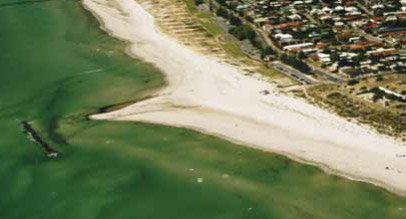
One of the new groynes installed at Somerton Park in 2005
Adelaide's Living Beaches - A Strategy for 2005-2025. Department for Environment and Heritage
Dune Conclusions
Dune restoration involves reducing the disturbance of dunes as a method of controlling erosion problems. Land-use planning needs to ensure buildings and infrastructure are positioned behind the dune system.
Land conservation groups recommend the careful retention of vegetation in sensitive areas and re-vegetation activities in cleared areas. This needs to be combined with the restriction of vehicular and human traffic. For this reason damaged and sensitive dunes might need to be fenced and access tracks for vehicles and people provided. This includes drift fencing, dune re-vegetation and access controls, together with the installation of educational signs and viewing areas at some locations
On many beaches, it is legal with the correct permits to bulldoze beaches to form "dunes" or at least to form piles of sand up against buildings for storm protection.
Bulldozed "dunes" have a different shape to natural dunes, and often look like large piles of sand that have been dumped on the beach. These piles of sand contain a lot of shell material which is a rare component of natural dune sand.
However, there are problems with bulldozing sand and artificial dunes. After a few days on the upper beach, wind will blow away the finer sand on the surface, causing a layer of shells or "shell lag" to form on the surface of a bulldozed dune. Because wind often can't blow shells into dunes, the shell lag is a positive indicator that the bulldozer has paid a visit.
Natural dunes, especially those with roots entangled throughout the sand, provide a solid (if temporary) barricade against a minor storm. When attacked by waves, a scarp or small bluff quickly forms. Subsequent waves are at least partly reflected from the scarp, rolling back down the beach and smashing into the next wave coming ashore. Bit by bit, however, the dune scarp moves landward under wave attack.
Helping to reinforce and strengthen natural dunes (in addition to the beneficial effect of plant roots) are electronic forces, or Vanderwaal forces, between the uniform sized sand grains and the water between the grains. In bulldozed "dunes", which are made up of beach sand with a wide size range of quartz grains and shell fragments, neither plant roots nor Vanderwaal forces are at work to stabilize the deposit.
Consequently the artificial dunes erode with much greater ease. The bulldozed sand, minus the animals that once lived there, returns to the beach (usually during the next storm) and the dunes are flattened and washed inland.
Bulldozing sand is not a good thing for beaches. Taking sand from any part of the beach is a form of beach erosion and it kills the organisms in the beach-the crabs, clams etc. and all the microscopic organisms that live between the sand grains.
For days after bulldozing, seagulls have an unexpected bonanza; swooping and grabbing the stranded and struggling critters of the beach that are now high and dry in the bulldozed dune. The odor of rotting organisms during the post-bulldozing time also can provide an unpleasant atmosphere for beach strollers. The process affects the whole food chain including the shorebirds and the near shore fish.
https://coastalcare.org/educate/sand-dunes/
The Tennyson Dunes Group supports a Conservation Reserve Discovery Trail that protects the fragile dune ecosystem, while allowing children and adults to learn about it. A current State Government trail plan is cause for concern over its proposed alignment, width, construction materials, boardwalks and fencing to accommodate cycling on the trail path.
The Tennyson Dune Group recommends the following Coastcare Code:
If you want to help dunes recover to their natural state here are some simple things you can do:
- Stay on paths
- Keep your dogs on leads
- Plant native plants in your garden
http://www.tennyson.org.au/assets/gardens.pdf - Keep your cats indoors
- Learn about dunes on the Native Plant Trail
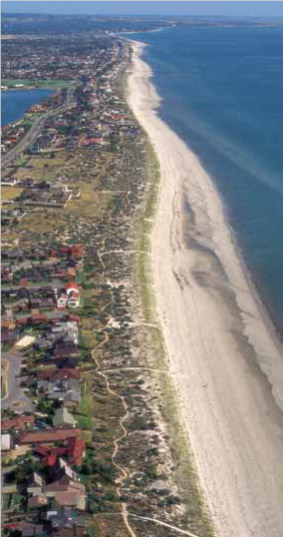
The Adelaide coastline, 1992 (South Australian Tourism Commission)
" The Beach Ecosystem is made up of living and non-living parts. Plants and animals and sand and water influence each other, often amidst breathtaking scenery. Greater than the sum of its parts, beaches sustain major portions of global biodiversity. With over half the world's population living within 50 km of the coast, human influence on that biodiversity is inevitable, making the study of beaches even more important.- https://coastalcare.org/educate/sand-dunes/
The environmentalist Rachel Carson wrote,
" In every curving beach, in every grain of sand, there is a story of the Earth.- https://preserveamerica.noaa.gov/week06/carson_pioneer.html
Researched, compiled and composed by Dr Steve Gration, January 2018 for Marine Discovery Centre
References
The Adelaide Metropolitan Coastline - South Australian Coast Protection Board No. 27 April 1993
Adelaide's Living Beaches - A Strategy for 2005-2025. Department for Environment and Heritage, Coastline No. 35 - 2005
https://www.ehp.qld.gov.au/coastal/ecology/beaches-dunes/coastal_dunes.html
http://www.tennyson.org.au/assets/gardens.pdf
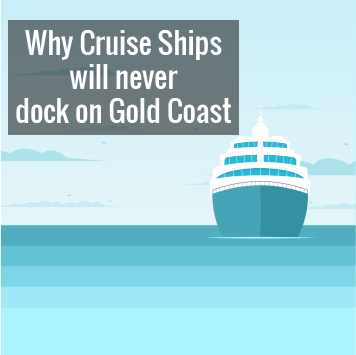 advanced search tips
advanced search tips
Other Articles
Oct 4, 2025 Shock Plans Uncovered for Wavebreak Island »
Nov 22, 2024 Hidden Beach Bar Report exposed »
Jun 17, 2024 Beach Bars - Community Reponse Required »
Jan 22, 2024 The 'forces of darkness' still active »
Jul 27, 2023 Australian Bush Medicine »
Mar 10, 2023 Council & State Attempt to Trash Spit Master Plan »
Dec 24, 2022 Drawing a Line in the Sand (Dunes) »
Mar 21, 2022 Australia's Best Beaches »
Nov 16, 2021 Foreign company given our beach for free »
Oct 14, 2021 Beach Bar Trial - All Splash No Substance »
Jun 26, 2020 AGM 2020 »
Jun 3, 2020 Tourism Gold Coast - part 3 »
Jan 14, 2020 Tourism Gold Coast - part 1 »
Jan 13, 2020 Tourism Gold Coast - part 2 »
Dec 16, 2019 AIR POLLUTION - Beyond the Haze »
Dec 4, 2019 Casino Report - Bias, Omission and Error »
Sep 4, 2019 THE DOG who finally caught the car! »
Mar 14, 2019 SOS analysis of draft Spit Master Plan »
Feb 22, 2019 CHINATOWN »
Sep 25, 2018 A Critical Analysis of the Second Casino Licence »
Aug 13, 2018 CST Attempt #15 Tugun Farce »
Aug 11, 2018 New 'Research Queen' to head Destination GC »
May 30, 2018 Regional Excellence Award - Winners »
May 14, 2018 Gold Coast Cruise Ship Terminal »
Apr 24, 2018 The Games are Over »
Jan 27, 2018 Spit Master Plan process has begun »
Dec 18, 2017 Spit Upgrades Launch »
Nov 24, 2017 Developer Donations Buying Favours and Influence »
Nov 22, 2017 Why we cannot trust them with Our Spit »
Nov 14, 2017 Supporting those who support us »
Oct 27, 2017 Bill for CST investigations could reach $12.5m »
Oct 7, 2017 In any other State but Queensland »
Sep 15, 2017 ABC 4 Corners probe GCCC re donations »
Aug 1, 2017 You Won - Spit Casino Cancelled »
Jul 31, 2017 SOSA AGM Monday 7th Aug »
Jul 5, 2017 Feasibility Study Costs »
Jun 6, 2017 Election promises? Not worth a cent! »
May 9, 2017 Silent Minority Exposed »
Apr 27, 2017 Collective Amnesia at CCC Hearing »
Apr 6, 2017 Light Rail loop-hole »
Mar 22, 2017 Consultation Sunday 26th 10:30 am »
Mar 10, 2017 Australian: ASF Financial Viability Woes »
Mar 8, 2017 Big Public Info Night Thurs 9th 6pm »
Feb 26, 2017 Has Lynham done secret deals with Tate? »
Feb 11, 2017 So again nothing new here Tom »
Feb 9, 2017 Survey Does Not Stack Up »
Feb 8, 2017 Warning new group compromised »
Jan 25, 2017 Napkin sketches and a dot point list »
Jan 19, 2017 Have you been consulted? »
Dec 20, 2016 Appealing Attractions - Casino ranked last »
Nov 26, 2016 Four Levels of Corruption »
Oct 8, 2016 A Murky Week in Gold Coast Politics »
Sep 6, 2016 Sunday Mail Casino Debacle »
Aug 27, 2016 Sunland Absurdity »
Aug 19, 2016 AGM Monday 22 6PM »
Jul 29, 2016 The State of Play »
Mar 17, 2016 Change is in the Air »
Feb 4, 2016 Rally in the Park Chevron Is Sunday »
Jan 31, 2016 The Elected Obfuscators Bluff »
Dec 20, 2015 A Christmas Message »
Nov 2, 2015 Peter Garrett re Cruise Ships »
Oct 15, 2015 Last chance to lodge your objection »
Oct 2, 2015 Back to the 1980s »
Sep 5, 2015 Broadwater and Spit Masterplan »
Aug 29, 2015 How to Report Potential Official Misconduct »
Jul 13, 2015 XCAT Farce Paradise Lost and more »
Jun 11, 2015 GCCC under review »
Jun 6, 2015 Another Radical Private Development »
Jun 1, 2015 My fun is more important than yours »
Apr 29, 2015 Economic Fear Campaign »
Mar 26, 2015 Reflections on the Water »
Feb 16, 2015 Project Terminal »
Feb 2, 2015 Election Result Sinks Gold Coast Terminal »
Jan 16, 2015 Tell the Truth - Public Meeting »
Dec 25, 2014 And so this is Christmas »
Dec 24, 2014 Seeney not winning friends on Coast »
Dec 19, 2014 The Numbers don't Lie »
Nov 21, 2014 Save our Spit Photographic and Art Show »
Nov 15, 2014 Senate Inquiry »
Nov 3, 2014 Grand Theft Wavebreak public rally »
Oct 23, 2014 Cronyism Exposed Again »
Oct 6, 2014 Greywater »
Sep 20, 2014 Expert Against Coast CST »
Sep 4, 2014 3 Events to attend »
Aug 30, 2014 Deputy Premiers Announcement »
Aug 23, 2014 The Hidden VDM report »
Jul 26, 2014 Politics and Rumours »
Jun 6, 2014 A call to action »
May 3, 2014 Move over Julia »
Apr 30, 2014 Just suck it up and say NO! »
Apr 25, 2014 That is not consultation »
Apr 8, 2014 Full Page Newspaper Propaganda Ads Begin »
Apr 5, 2014 Report revealed »
Apr 1, 2014 April Fools Day with flawed survey »
Mar 24, 2014 Questions our GC Councillors must ask ASF »
Mar 14, 2014 Hey small spender »
Feb 24, 2014 Surf threatened by CST »
Feb 19, 2014 Tate considers quitting »
Feb 14, 2014 Live blog with Mayor Tom Tate »
Feb 14, 2014 Gration for Mayor 2016 »
Feb 5, 2014 Currumbin under threat from dredging »
Jan 28, 2014 What is a SLAPP Suit? »
Jan 15, 2014 It's a whole of city issue »
Jan 1, 2014 Cowards Lies and China Syndrome »
Dec 30, 2013 North Kirra Cruise Ship Terminal »
Dec 30, 2013 Mick Fanning speaks out on Kirra CST »
Dec 14, 2013 Councillors unaware of Brisbane CST »
Nov 29, 2013 Grand Theft Land »
Nov 16, 2013 The Hidden Urbis Report »
Oct 24, 2013 2013 Gold Coast Media Awards »
Oct 21, 2013 State vs State vs Mate »
Oct 19, 2013 What actually happened at the vote »
Oct 18, 2013 Dear Councillor »
Sep 12, 2013 Ship visits raise concern »
Sep 6, 2013 Vote 1 Save Our Spit »
Aug 24, 2013 Mayor Plays the victim »
Aug 24, 2013 Cruise Industry Forum Cancelled »
Aug 14, 2013 Secret Study values Broadwater at $4.1 b »
Aug 10, 2013 AGM 2012-13 Sep 10 7pm »
Aug 10, 2013 CST Bidder pulls out »
Jun 23, 2013 Cruise Ship Terminal in doubt »
Jun 6, 2013 Q and A info Night »
May 29, 2013 Joel cans Terminal idea »
May 22, 2013 AECgroup Business Case Analysis »
Apr 22, 2013 CMC probe into Oceanway »
Apr 14, 2013 Secret letters and meetings »
Apr 8, 2013 CMC under LNP attack »
Apr 4, 2013 Golden myopia »
Mar 16, 2013 Green Sea Turtle May have paid Price »
Mar 9, 2013 Golden Opportunity Missed »
Mar 6, 2013 Controlled Messaging Fails »
Mar 4, 2013 Open for Business »
Mar 2, 2013 Gambling with our coastline »
Feb 17, 2013 Gold Coast Waterways Authority Appointees »
Feb 9, 2013 Expressions of Interest Broadwater Marine Project »
Feb 2, 2013 Analysis of the navigational report 2012 »
Jan 26, 2013 Survey Called into Question »
Jan 19, 2013 Light Rail court battle with Council »
Dec 18, 2012 Bob Katter makes it a Federal issue »
Dec 18, 2012 Self-interest rather than vision »
Dec 13, 2012 A history lesson »
Dec 13, 2012 Land grab confirmed by report »
Dec 12, 2012 Community Information Session 10AM Thurs 13th »
Dec 6, 2012 Selling off our public land and water! »
Dec 5, 2012 Shoals vital to quality waves at Strad »
Dec 3, 2012 A bad week and month for LNP »
Nov 29, 2012 The unethical removal of Dr Alex Douglas »
Nov 25, 2012 No one voted for this »
Nov 13, 2012 Annastacia stands up for the community »
Nov 10, 2012 Father Son »
Nov 10, 2012 The Younger Generation Get It »
Nov 6, 2012 Rally gets Australia wide attention »
Nov 3, 2012 RIP Angus »
Oct 27, 2012 Ignored Tax and Rate payer »
Oct 27, 2012 Broadwater water quality degrading »
Oct 27, 2012 In Union there is strength »
Oct 20, 2012 Leadership not spin »
Oct 16, 2012 Comparing apples with apples »
Oct 12, 2012 Not the Panacea of Gold Coast Economic Woes »
Oct 8, 2012 Divide and Conquer - Trade Off »
Oct 5, 2012 Dawny lets us down »
Oct 3, 2012 Joel Parkinson - thanks »
Oct 2, 2012 Thanks for the support Occy »
Oct 1, 2012 Free Like Me »
Oct 1, 2012 Gold Coast Bulletin backs the people »
Sep 23, 2012 Sembawang disappears into a puff of logic »
Sep 21, 2012 Thanks for the support Kelly »
Sep 19, 2012 Mick Fanning is a legend »
Sep 11, 2012 Ship Terminal Sembawang Wave Break Survey »
Sep 3, 2012 No support for Sembawang Proposal »
Sep 3, 2012 A letter to the Premier »
Aug 28, 2012 Russ Hinze changed his mind 1980 »
Aug 22, 2012 Facebook saving our spit »
Aug 21, 2012 Is the Spit Man Made? »
Aug 14, 2012 The qu is NOT where but WHY? »
Aug 2, 2012 Lose Kirra or Straddie »
Jul 27, 2012 Hello SGC Business Leaders »
Jul 23, 2012 Cruise Ship Terminal - White Elephant »
Jul 17, 2012 Dear Mr Tate »
Jul 9, 2012 City Backs Terminal - NOT »
Jun 22, 2012 Join Us »
Jun 22, 2012 Public Open Space »
Jun 12, 2012 AGM 2011-12 Thurs 21 June 7 pm »
Jun 8, 2012 Dear Mayor and Councillors »
May 31, 2012 A Casino spitting ships »
Apr 26, 2012 Not printed in the local paper »
Mar 3, 2012 Kelly Slater video helps SOSA »
Feb 22, 2012 Broadwater Community Reference Group »
Jan 16, 2012 Cruise Mishap a reminder to us »
Sep 29, 2011 Broadwater Management Plan »
Jun 11, 2011 AGM 2011 Wed 13th »
Oct 22, 2010 Cruise Ship Tourists may not spend »
Aug 31, 2010 Another Broadwater plan »
Jul 20, 2010 Gold Coast Bulletin Frenzy »
Jul 14, 2010 A supporters spit »
Apr 29, 2010 AGM 2010 Tues 18 th May »
Nov 26, 2009 Rich dumping filth in our Broadwater »
Sep 14, 2009 ITU World Triathlon great for Gold Coast »
Sep 1, 2009 letter - Dead section of the Spit »
May 25, 2009 President has a SPIT »
May 13, 2009 AGM 2009 Wed May 27th 6-8 pm »
Apr 24, 2009 Medico supports SOSA »
Apr 1, 2009 Tides of Change - Have your say »
Mar 17, 2009 Navigational Study No Secret »
Feb 25, 2009 News Beatups »
Jan 11, 2009 Safely sharing the seaway »
Oct 24, 2008 Catalyst - invasive species by boat »
Oct 4, 2008 Save Our Spit Stickers Available »
Sep 22, 2008 Government Architect Mr Philip Follent »
Sep 10, 2008 Straddie saved from Receding Hairline »
Sep 4, 2008 Terminal Politicians »
Jul 4, 2008 Terminal terminated so Move On »
May 28, 2008 The Good, The Bad & the Ugly »
May 14, 2008 Oceanway Pathway debacle »
May 14, 2008 GCCC Bulldozes Spit Dunes »
Apr 19, 2008 Celebrate a few victories »
Mar 16, 2008 Domestic visitors spend $3 b on Gold Coast »
Mar 11, 2008 Council Election 2008 »
Jan 8, 2008 Christmas Greeting 2007 »
Jan 2, 2008 Letter to John Mickell MP »
Nov 21, 2007 Friends of Federation Walk new website »
Sep 26, 2007 Paul Lucas pushing Marine Simulator »
Aug 6, 2007 Developers on notice re Local Area Plan »
Aug 4, 2007 Protection for the Gold Coast Spit at last! »
Aug 4, 2007 Premier Beattie Saves Our Spit »
Jul 18, 2007 Spit Training Centre Threat »
May 18, 2007 Lessons from Los Angeles »
Apr 25, 2007 Another Storm for the Spit »
Apr 16, 2007 State Government Threatens Spitů Again »
Apr 13, 2007 Gold Medal Winner and the Spit »
Mar 27, 2007 Sean's letter »
Feb 23, 2007 Sea World Ferris Wheel Fiasco »
Jan 29, 2007 Reignited Protests »
Jan 19, 2007 Financial Review Article - Millionnaire Greenies »
Nov 17, 2006 Beach Spirit Award Winners - The Spit »
Nov 14, 2006 Cruise liner dumps oil in Paradise »
Nov 11, 2006 Developer 'Vision' Not 20:20, say Spitfighters »
Nov 9, 2006 Government plans for future Spit vision: Bligh »
Oct 13, 2006 What a difference 48 hours makes »
Sep 10, 2006 Government Speak »
Sep 10, 2006 Boating Industry views »
Aug 28, 2006 Super Yachts OK- in the Right Place »
Aug 11, 2006 The SpitFight Goes To Canberra »
Aug 5, 2006 Gold Coast Bully - Taken to Task »
Jul 14, 2006 Natural tourism drawcard threatened - Alan Midwood »
Jun 25, 2006 Greatest City Dive at Risk »
Jun 22, 2006 Whales Spotted in Proposed Terminal Site »
Jun 13, 2006 Our letters sent to Peter Beattie via Peter Lawlor »
Jun 11, 2006 Peta-Kaye Croft ignores her constituents on SOS »
Jun 1, 2006 Letter to Gold Coast Bulletin - I am not a Green »
May 31, 2006 A letter to Anna Bligh from Gecko »
May 31, 2006 Spitfighters Fight Back - Life Weekly article »
May 27, 2006 Sailing into murky waters »
May 20, 2006 Life Weekly Magazine article »
May 10, 2006 Gold Coast City Marina - Exposed »
May 3, 2006 Athletes fight to Save their training ground »
Apr 22, 2006 Notional Shipping Terminal Confirms Public Losses »
Apr 21, 2006 Save Our Spit- from Strength to Strength »
Apr 21, 2006 Overseas Cruise Ship Campaigners »
Apr 2, 2006 Gaven - Ominous warning to the Beattie Government »
Mar 30, 2006 What the Gaven by-Election Candidates said »
Mar 23, 2006 Gaven by-Election Media Release »
Mar 19, 2006 Peter Beattie meets SOSA at Robina »
Mar 12, 2006 An historical journey »
Mar 5, 2006 Surf cola »
Mar 5, 2006 Storm surf breaks across Seaway »
Feb 21, 2006 Labor 'greed' on tunnel fiasco - sounds familiar »
Feb 19, 2006 Surf Rage »
Feb 17, 2006 Surfrider - media release »
Feb 13, 2006 Gold Coast - too good for a shipping terminal »
Feb 13, 2006 Peter Beattie and co's dancing figures »
Feb 8, 2006 Master Mariner questions sanity of proposal »
Feb 5, 2006 Surfers promise to wipe out Labor »
Feb 5, 2006 Councillor Susie Douglas's inspiring rally speech »
Feb 3, 2006 Letters to the 'Bully' »
Jan 25, 2006 Surfrider says »
Jan 24, 2006 Pro Terminal threaten to attend rally »
Jan 12, 2006 Public Rally Feb 5th 12 noon »
Jan 11, 2006 Anna Bligh confirms it's not a done deal »
Jan 9, 2006 Who Murdered Mundaka - is Straddie next? »
Dec 21, 2005 MP's Ciobo and Langbroek not happy »
Dec 16, 2005 Ms Levy's band of do-gooders »
Nov 28, 2005 A new Picture - future Spit »
Nov 23, 2005 Anna Bligh and misinformation »
Nov 11, 2005 Bulletin gone quiet »
Nov 5, 2005 Surfrider Foundation's support »
Nov 5, 2005 US Forces get the nod »
Nov 1, 2005 The Global War on Tourism »
Oct 25, 2005 Are Cruise Ships getting too big? »
Oct 14, 2005 Meeting Tuesday 18th October SOS »
Oct 13, 2005 Brad Farmers Message - Letter to the editor »
Oct 11, 2005 A very personal attachment to the Spit »
Oct 10, 2005 Map - SOS opposition to Government Plans »
Oct 7, 2005 Increased Cancer Risk From LA Port Complex Fumes »
Oct 6, 2005 From Strength to Strength in our campaign »
Sep 28, 2005 Venice Sinking under cruise ships »
Sep 21, 2005 Thats not reality but this is »
Sep 18, 2005 EIS rubber stamp? »
Sep 5, 2005 Letter to Bulletin »
Aug 29, 2005 Excerpts: »
Aug 28, 2005 Plans for lakes of effluent on Straddie !!! »
Aug 23, 2005 Not Exactly The Love Boat - New Book »
Aug 3, 2005 Premier sinking Gold Coast dive industry »
Aug 2, 2005 Thumbs up for Councillor Susie Douglas »
Aug 1, 2005 World Class Waves at Risk »
Jul 18, 2005 New Stickers Available »
Jul 18, 2005 Save our spit campaign highlights »
Jul 18, 2005 People and Parks Day Sunday 31st July »
Apr 20, 2005 Trinity Lutheran College Cruise Ship Debate »

